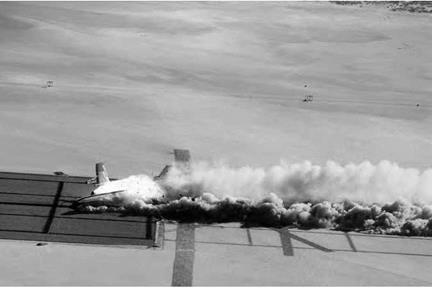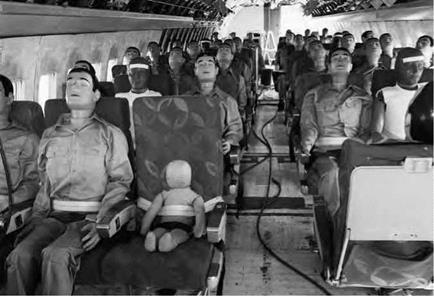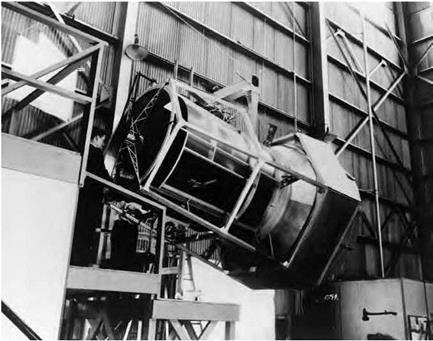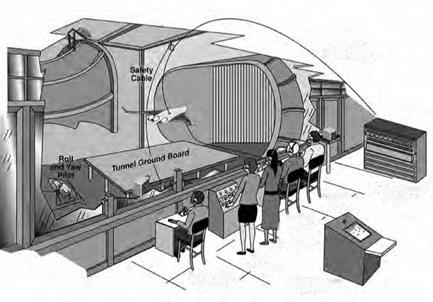Coping With Lightning: A Lethal Threat to Flight
Barrett Tillman and John L. Tillman
The beautiful spectacle and terrible power of lightning have always inspired fear and wonder. In flight, it has posed a significant challenge. While the number of airships, aircraft, and occupants lost to lightning have been few, they offer sobering evidence that lightning is a hazard warranting intensive study and preventative measures. This is an area of NASA research that crosses between the classic fields of aeronautics and astronautics, and that has profound implications for both.
u I LEARNED MORE ABOUT LIGHTNING from flying at night over Bosnia while wearing night vision goggles than I ever learned from a meteorologist. You’d occasionally see a green flash as a bolt discharged to the ground, but that was nothing compared to what was happening inside the clouds themselves. Even a moderate-sized cloud looked like a bubbling witches’ cauldron, with almost constant green discharges left and right, up and down. You’d think, "Bloody hell! I wouldn’t want to fly through that!” But of course you do, all the time. You just don’t notice if you don’t have the goggles.”[112]
So stated one veteran airman of his impressions with lightning. Lightning is an electrical discharge in the atmosphere usually generated by thunderstorms but also by dust storms and volcanic eruptions. Because only about a fourth of discharges reach the ground, lightning represents a disproportionate hazard to aviation and rocketry. In any case, lightning is essentially an immense spark that can be many miles long.[113]
Lightning generates radio waves. Scientists at the National Aeronautics and Space Administration (NASA) discovered that very low frequency (VLF) waves cause a gap between the inner and outer Van Allen radiation belts surrounding Earth. The gap offers satellites a potential safe zone from solar outburst particle streams. But, as will be noted, protection of spacecraft from lightning and electromagnetic pulses (EMPs) represents a lasting concern.
There are numerous types of lightning. By far the most common is the streak variety, which actually is the return stroke in open air. Most lightning occurs inside clouds and is seldom witnessed inside thunderstorms. Other types include: ball (spherical, semipersistent), bead (cloud to ground), cloud-to-cloud (aka, sheet or fork lightning), dry (witnessed in absence of moisture), ground-to-cloud, heat (too distant for thunder to be heard), positive (also known as high-voltage lightning), ribbon (in high crosswinds), rocket (horizontal lightning at cloud base), sprites (above thunderstorms, including blue jets), staccato (short cloud to ground), and triggered (caused by aircraft, volcanoes, or lasers).
Every year, some 16 million thunderstorms form in the atmosphere. Thus, over any particular hour, Earth experiences over 1,800. Estimates of the average global lightning flash frequency vary from 30 to 100 per second. Satellite observations produce lower figures than did prior scientific studies yet still record more than 3 million worldwide each day.[114] Between 1959 and 1994, lightning strikes in the United States killed 3,239 people and injured a further 9,818, a measure of the lethality of this common phenomenon.[115]
Two American regions are notably prone to ground strikes: Florida and the High Plains, including foothills of the Rocky Mountains. Globally, lightning is most common in the tropics. Therefore, Florida records the most summer lightning strikes per day in the U. S. Heat differentials between land and water on the three sides of peninsular Florida, over its lakes and swamps and along its panhandle coast, drive air circulations that spin off thunderstorms year-round, although most intensely in summer.
Lightning: What It Is, What It Does
Despite recent increases in understanding, scientists are still somewhat mystified by lightning. Modern researchers might concur with stone age shaman and bronze age priests that it partakes of the celestial.
Lightning is a form of plasma, the fourth state of matter, after solids, liquids, and gases. Plasma is an ionized gas in which negatively charged electrons have been stripped by high energy from atoms and molecules, creating a cloud of electrons, neutrons, and positively charged ions.
As star stuff, plasma is by far the most common state of matter in the universe. Interstellar plasmas, such as solar wind particles, occur at low density. Plasmas found on Earth include flames, the polar auroras, and lightning.
Lightning is like outer space conditions coming fleetingly to Earth. The leader of a bolt might zip at 134,000 miles per hour (mph). The energy released heats air instantaneously around the discharge from
36,0 to 54,000 degrees Fahrenheit (°F), or more than three to five times the Sun’s surface temperature. The sudden, astronomical increase in local pressure and temperature causes the atmosphere within and around a lightning bolt to expand rapidly, compressing the surrounding clear air into a supersonic shock wave, which decays to the acoustic wave perceived as thunder. Ranging from a sharp, loud crack to a long, low rumble, the sound of a thunderclap is determined by the hearer’s distance from the flash and by the type of lightning.
Lightning originates most often in cumulonimbus thunderclouds. The bases of such large, anvil-shaped masses may stretch for miles. Their tops can bump up against, spread out along, and sometimes blast through the tropopause: the boundary between the troposphere (the lower portion of the atmosphere, in which most weather occurs) and the higher stratosphere. The altitude of the lower stratosphere varies with season and latitude, from about 5 miles above sea level at the poles in winter to 10 miles near the equator. The tropopause is not a "hard” ceiling. Energetic thunderstorms, particularly from the tropics, may punch into the lower stratosphere and oscillate up and down for hours in a multicycle pattern.















